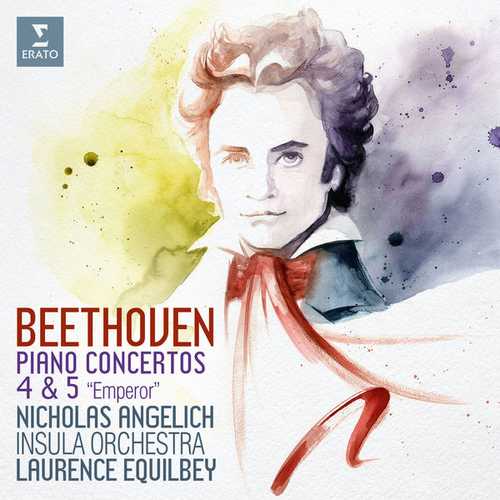

Composer: Ludwig van Beethoven
Performer: Nicholas Angelich
Orchestra: Insula Orchestra
Conductor: Laurence Equilbey
Format: FLAC (tracks)
Label: Erato
Catalogue: 9029563417
Release: 2018
Size: 1.21 GB
Recovery: +3%
Scan: yes
Piano Concerto No. 4 in G major, Op. 58 (Live)
01. I. Allegro moderato
02. II. Andante con moto
03. III. Rondo. Vivace
Piano Concerto No. 5 in E flat major, Op. 73 ‘Emperor’ (Live)
04. I. Allegro
05. II. Adagio un poco mosso
06. III. Rondo. Allegro ma non troppo
Nicholas Angelich plays Beethoven’s Piano Concertos Nos 4 and 5 on a period instrument – a Pleyel concert grand built 65 years after the composer’s death – with a team noted for historically informed performance: the Insula Orchestra and it conductor-founder Laurence Equilbey. “I see this recording as offering something new,” says Equilbey, “respecting the musical text, and the sonorities and spirit of Beethoven’s own time, whilst also seeking the kind of atmosphere and amplitude that speak to us today.”
In several ways, this is a completely fresh reading of Beethoven’s Piano Concerto No. 4 in G major, Op. 58, and Piano Concerto No. 5 in E flat major, Op. 73 (“Emperor”). Given the sheer volume of interpretations on the market, that’s not an easy thing to achieve, and regardless of what your impressions may be of what pianist Nicholas Angelich and conductor Laurence Equilbey have accomplished here, this is the kind of recording that demands to be heard. There are historically oriented performances of Beethoven, but this one falls into a rarer category, for Beethoven at least: the recording that is informed by historical practices, but does not submerge itself in them. Angelich’s piano is an early, 20th century Pleyel instrument, pointed and clear without being especially loud.
The Insula Orchestra is small and plays on period instruments. The result is a light, transparent sound that evokes the orchestras of Beethoven’s time in its dimensions. Equilbey and Angelich further state that they aim to cultivate an improvisatory feel in these two concertos. In the Piano Concerto No. 4 this works beautifully. The general dynamic level is quiet; the music seems to rise at the beginning from a point of stasis; and the whole reading seems spontaneous, even though it has clearly been worked out down to small details. The Piano Concerto No. 5, self-consciously grand, would seem a more difficult candidate for such treatment, but Angelich delivers percussive power where necessary, for instance in the big piano entrance and arpeggio flourish in the first movement. And sample the finale, around the three-minute mark for instance, where Angelich and Equilbey find a strong element of dialogue that has escaped other musicians. The sound engineering from Insula’s Seine Musicale home base is an excellent aid to the whole enterprise, which is strongly recommended.



